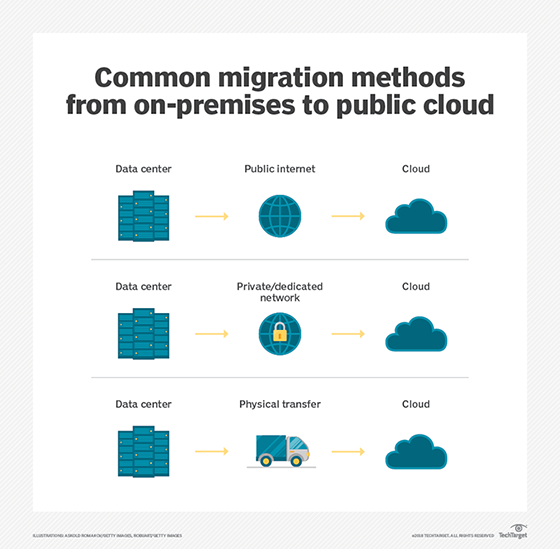
vali_111 - Fotolia
A cloud migration roadmap for CIOs
Migrating workloads to the cloud can be a daunting task -- but with a roadmap in place, CIOs are better equipped to make decisions that will help ensure the migration is a success.
To get the real benefits of the cloud, CIOs need a strategic cloud migration roadmap. This may sound obvious, but a surprisingly large number of CIOs continue to migrate to the cloud haphazardly with a minimal plan in place.
Most enterprises find themselves in a deeply hybridized service delivery environment, with several major and minor services delivered from the cloud as SaaS apps or via IaaS systems. However, the average CIO still has about 40% of IT workloads running in a data center.
Today, CIOs want to do more with cloud or do better with cloud. There is a lot of pressure on enterprises with a large percentage of workloads still running in-house to move more to a cloud environment. And this pressure has many roots -- executives may want to move everything to the cloud to get "IT out of the data center business." Others may move some of their workload to help optimize spending or to minimize risk and improve agility and scalability.
But simply pushing applications and services to the cloud in a disorganized manner is a recipe for failure. That's why CIOs need a cloud migration roadmap.
Determine the business goals of migrating to the cloud
There are several key questions to answer before embarking on a cloud migration:
- What is the desired end state? There are organizations that have high-level direction from a CEO that they are to be 100% cloud-based; others do not. The CIO should be leading in the absence of a firm directive, and advising where there is one in a more measured direction -- not aiming for a specific percentage in the cloud per se, but instead focusing on optimizing workload placement to meet business needs in the context of IT's guiding principles.
- What are the primary business goals of the cloud migration? If the focus is on reducing costs, that can lead to different decisions than if the focus is on reducing risk, improving customer experience (CX), or minimizing the difficulty of acquiring or divesting other companies. Understanding the business drivers that the cloud will support is crucial.
- What are the technology principles that best support those business goals? The IT space has a long list of design principles that can be brought to bear in planning, such as building instead of buying or configuring instead of coding. Before settling on specific technologies or product offerings, IT leadership needs a clear idea of the design principles it will embrace so that it can better identify the characteristics needed in the technologies and products. For example, consider the following:
- Determine whether the focus should be on building cloud services to replace on-premises services or buying into and adapting to market-leading SaaS options. If the business driver is optimized CX, that can lead IT to emphasize build over buy. If the business driver is minimized costs, it might be the other way around.
- Determine whether the emphasis should be on a best-in-class, single-platform or ecosystem solution. If further cloud migration is driven by a need for agility, that could favor the best-in-class approach; if there is a business goal to reduce staffing in IT, that might push for a single-platform or ecosystem approach.
- Which technologies best realize the technology principles? That is, without consideration of specific offerings, what categories of technology best support the design principles chosen? For instance, if the design principle is that all workers have some involvement in using software, then adoption of low-code and no-code development tools will likely be on the roadmap, as opposed to where the emphasis is on buying or configuring.
Once a CIO and their organization decides on these points, they can really begin laying out a roadmap for migrating systems and selecting the platforms to migrate them to as well as the tools to migrate with.

Assess cloud readiness of apps and services
Of course, building a detailed cloud migration roadmap of system-by-system migrations requires far more effort than a piecemeal approach. Getting through the fundamentals leaves IT leaders positioned to make the succeeding decisions more quickly and efficiently.
The most important of the remaining concerns is in what order to migrate the systems. This is governed by many factors, but the chief among them should be business risk. For most organizations, the basic premise should be to start with lower-risk systems earlier in the migration process and work up to the ones with higher risk, thus building expertise along the way in both the migration and the operation of systems in the new environments.
Assessments of risk should be made in a structured and consistent way involving not just IT, but also the lines of business as well as security and risk management teams.
Most of the remaining work of building and maintaining a cloud migration roadmap depends on building mechanisms such as the following:
- special change management request types for the migrations;
- a system dependency map and a data affinity map to help sequence and group migrations;
- a workload placement process for deciding where workloads will go;
- a migration dashboard for C-level leadership; and
- system-by-system update channels for communicating with each system's stakeholders.
CIOs will have no end of encouragement to migrate to the cloud, but doing it successfully depends on doing it properly, and therefore, a roadmap is indispensable.








